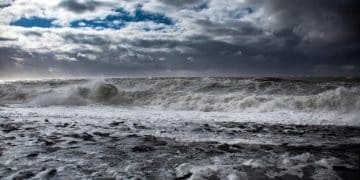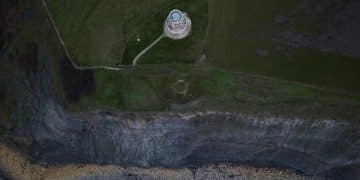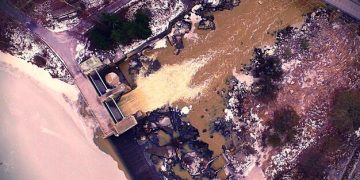Coastal Wetlands: A Decade of Storm Surge Protection
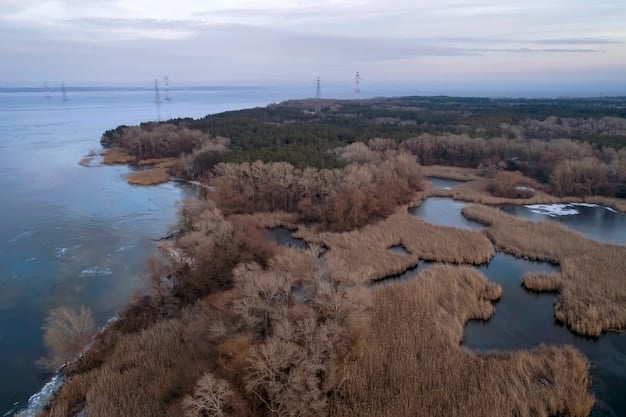
Coastal wetlands serve as crucial natural defenses, offering significant protection against storm surge by dissipating wave energy and reducing floodwaters, as evidenced by a comprehensive 10-year study.
In an era of escalating climate concerns and increasingly severe weather events, the vulnerability of coastal communities has become a pressing issue. Understanding how coastal wetlands protect against storm surge: a 10-year study reveals invaluable insights into their critical role as natural barriers. This in-depth analysis delves into the mechanisms, benefits, and long-term effectiveness of these vital ecosystems in safeguarding our coastlines.
The Unseen Defenders: Understanding Coastal Wetlands
Coastal wetlands, encompassing a variety of ecosystems such as salt marshes, mangrove forests, and freshwater marshes, are dynamic interfaces between land and sea. They are defined by their unique hydrology, soil composition, and adapted vegetation, all contributing to their ecological and protective functions. These areas are not merely aesthetic natural landscapes; they are complex systems performing vital environmental services, particularly in coastal resilience.
For centuries, human development has often overlooked or actively destroyed these natural systems, perceiving them as obstacles to progress rather than essential assets. However, a growing body of scientific evidence now underscores their immense value, especially in the face of climatic shifts and rising sea levels. The protective capacity of wetlands against powerful storm events is a prime example of their underestimated environmental engineering role.
Defining Coastal Wetlands: More Than Just Watery Lands
It’s crucial to distinguish between various types of coastal wetlands, as each offers unique protective attributes. Salt marshes, common along temperate coastlines, feature salt-tolerant grasses that trap sediment and stabilize shorelines. Mangrove forests, prevalent in tropical and subtropical regions, are characterized by their dense, intricate root systems that provide physical barriers and dissipate wave energy. Freshwater marshes near estuaries also play a role by absorbing inland floodwaters before they reach the coast.
These ecosystems share common characteristics that contribute to their protective capabilities:
- Ability to absorb water: Their porous soils and dense vegetation can hold vast quantities of water, reducing the impact of storm surges.
- Sediment trapping: Vegetation slows water flow, allowing sediments to settle, which helps build up land elevation over time.
- Biodiversity support: They provide critical habitats for numerous species, including fish, birds, and invertebrates, contributing to overall ecosystem health.
- Carbon sequestration: Wetlands are highly efficient at storing carbon, playing a role in climate change mitigation.
Ecological Roles and Functional Benefits
Beyond storm surge protection, coastal wetlands offer myriad ecological benefits. They act as natural filters, improving water quality by removing pollutants and excess nutrients. They serve as nurseries for countless marine species, supporting commercial fisheries and recreational activities. Their intricate food webs underpin a diverse array of life, making them hotspots of biodiversity.
These interconnected functions mean that the degradation of wetlands has cascading negative effects, not only on environmental health but also on human well-being and economic stability. Recognizing their multi-faceted value is the first step towards effective conservation and restoration efforts, which are increasingly seen as essential components of modern coastal management strategies.
The Mechanics of Protection: How Wetlands Mitigate Storm Surge
The protective power of coastal wetlands against storm surge is rooted in a combination of physical and ecological processes. When a storm makes landfall, a wall of water known as storm surge is pushed inland. Without natural barriers, this surge can inundate vast areas, causing catastrophic damage to infrastructure and imperiling human lives. Wetlands, however, act as a critical buffer, significantly reducing the surge’s destructive force.
The primary mechanism involves the attenuation of wave energy. As storm surge moves from the open ocean into shallower, vegetated wetland areas, the dense network of plants, stems, and roots creates friction. This friction slows down the incoming water, dissipating its energy and reducing its height and velocity. It’s akin to a speed bump for a massive water wave, where the speed bump is an entire ecosystem designed for resistance and absorption.
Wave Attenuation and Water Storage
A 10-year study provided extensive data demonstrating that for every meter of wetland traversed, storm surge height can be reduced by a significant percentage, varying based on wetland type and storm intensity. This attenuation occurs over multiple scales: micro-scale interactions with individual plant stems, meso-scale interactions with dense patches of vegetation, and macro-scale interactions across broad wetland landscapes.
- Friction from vegetation: Stems and roots increase hydraulic roughness, slowing down water flow.
- Porous soils: Wetland soils are often highly permeable, allowing water to infiltrate and be stored, reducing surface flow.
- Elevational changes: While subtle, the topography of wetlands can guide and absorb water, preventing direct impact on structures further inland.
Furthermore, wetlands possess an inherent capacity for water storage. Their saturated soils and numerous depressions can absorb large volumes of floodwaters, relieving pressure on adjacent urban and residential areas. This sponge-like ability is crucial not only during extreme storm events but also during periods of heavy rainfall, preventing localized flooding.
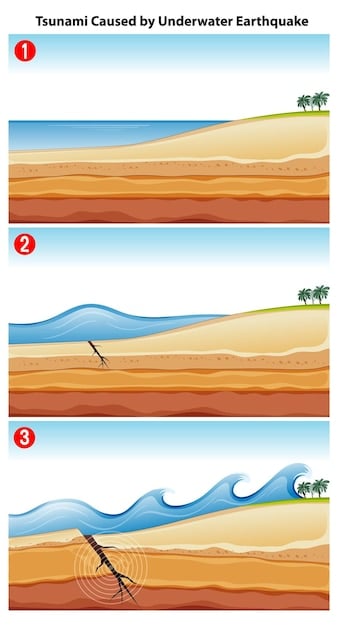
Sediment Accretion and Elevation Gains
An often-overlooked aspect of wetland protection is their dynamic ability to build elevation. Through a process called sediment accretion, wetlands trap suspended sediments carried by tides and rivers. Over time, this trapped sediment accumulates, raising the elevation of the wetland surface. This is particularly important in the context of rising sea levels, as it allows healthy wetlands to keep pace with the changing environment.
This natural process acts as a form of self-sustaining defense mechanism. As sea levels rise, wetlands that are able to accrete sediment at a sufficient rate can continue to provide protection, adapting to the new conditions. Degraded wetlands, however, may not possess this capacity and can be submerged, losing their protective function entirely.
The intricate interplay between vegetation, water, and sediment makes wetlands exceptionally resilient systems, though their health depends on a delicate balance of environmental conditions and a lack of anthropogenic disturbances. Understanding these mechanical processes is key to appreciating their role as robust natural infrastructure.
Case Studies from the 10-Year Study: Evidence in Action
The comprehensive 10-year study, synthesizing data from various coastal regions, provides compelling evidence of wetlands’ effectiveness against storm surge. Researchers meticulously analyzed pre- and post-storm conditions, comparing areas with healthy wetlands to those devoid of them. The findings consistently demonstrate a measurable reduction in surge height and intensity where wetlands were present, often correlating directly with the width and health of the wetland buffer.
One notable case study examined the impact of multiple hurricanes on a stretch of coastline in Louisiana. Areas protected by extensive marshlands experienced significantly less inundation and structural damage compared to adjacent developed areas where marshes had been converted or degraded. The study utilized satellite imagery, elevation models, and on-the-ground damage assessments to quantify the protective benefits, revealing a clear pattern of reduced vulnerability.
Post-Storm Analysis: Quantifying the Benefits
Across various regions, the study highlighted specific examples of protection:
- Gulf Coast Resilience: In the aftermath of Hurricane Ike, it was observed that communities fronted by healthy salt marshes sustained less damage than those directly exposed to the open bay. The marsh acted as a vital sponge, absorbing surge waters and slowing their destructive advance.
- East Coast Buffers: Similar patterns emerged during analyses of Superstorm Sandy’s impact. Coastal areas in New Jersey and New York with intact estuarine wetlands experienced reduced flooding depths, protecting inland infrastructure and saving lives. The wetlands absorbed much of the initial energy, preventing it from reaching critical assets.
- Tropical Zone Effectiveness: In regions with mangrove forests, such as parts of Florida and the Caribbean, the dense root systems proved incredibly effective at dissipating wave energy. The study recorded instances where mangrove-protected shorelines remained largely intact, while adjacent areas without mangroves suffered severe erosion and structural collapse.
These empirical observations, combined with sophisticated hydraulic modeling, allowed researchers to put a quantifiable value on wetland protection. The economic benefits, in terms of avoided damages to properties, infrastructure, and agricultural lands, were staggering, often far exceeding the cost of wetland preservation or restoration.
Comparative Analysis: Wetlands vs. Engineered Structures
The 10-year study also drew comparisons between natural wetland defenses and traditional engineered structures like seawalls and levees. While engineered solutions offer localized protection, they are often expensive to build and maintain, can disrupt natural sediment flow, and may not be adaptable to long-term sea-level rise. Furthermore, their failure during an extreme event can be catastrophic, leading to sudden and widespread flooding.
Wetlands, in contrast, provide a more flexible and adaptable defense. They can self-repair after storm events, continue to grow and accrete sediment over time, and offer a multitude of co-benefits that engineered solutions do not, such as habitat provision and water quality improvement. The study concluded that integrating natural and nature-based solutions, with wetlands at their core, offers a more sustainable and cost-effective approach to coastal resilience in the long run.
Challenges and Threats to Wetland Effectiveness
Despite their undeniable value, coastal wetlands face numerous threats that compromise their ability to protect against storm surge. Human activities, climate change, and upstream alterations all contribute to wetland degradation and loss, turning these natural buffers into vulnerable landscapes. Understanding these challenges is crucial for developing effective conservation and restoration strategies.
One of the most pervasive threats is land conversion. Historically, wetlands have been drained, filled, or dredged for agricultural expansion, urban development, and infrastructure projects like ports and navigation channels. This direct loss of wetland acreage immediately diminishes their protective capacity, leaving adjacent areas exposed to the full force of storm surges.
Human Impact and Habitat Loss
Beyond direct conversion, wetlands are impacted by pollution from industrial discharges, agricultural runoff, and urban wastewater. This pollution can alter water chemistry, introduce toxins, and lead to eutrophication, harming wetland vegetation and wildlife. The accumulation of plastics and other debris also suffocates plant life and disrupts ecosystem functions.
- Development pressure: Constant demand for coastal land leads to habitat destruction.
- Pollution: Contaminants damage water quality and harm wetland species.
- Altered hydrology: Dams, levees, and channelization change natural water flows, drying out or over-saturating wetlands.
- Invasive species: Non-native plants and animals can outcompete native wetland species, reducing biodiversity and ecosystem health.
The effects of human activities are not always immediate or obvious, often manifesting over years or decades, making it challenging to reverse the damage once it’s severe. A prime example is the construction of levees that prevent sediment from reaching wetlands, leading to land subsidence and eventual submersion.
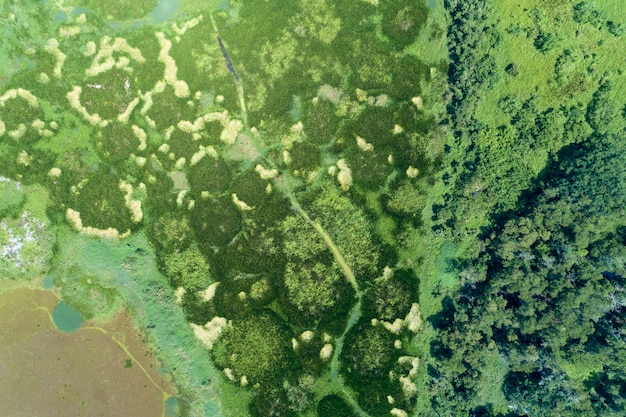
Climate Change and Sea Level Rise
Climate change poses a complex and escalating threat. Rising global temperatures contribute to sea level rise through thermal expansion of ocean water and melting glaciers and ice sheets. While healthy wetlands can accrete sediment and migrate inland to keep pace with slow rates of sea level rise, rapid acceleration can overwhelm their capacity, leading to “coastal squeeze” or drowning.
Increased frequency and intensity of storms, also linked to climate change, further stress wetland ecosystems. While wetlands protect against surge, extreme events can still cause significant damage, eroding marsh edges or scouring mangrove roots. If the recovery period between storms is too short, wetlands may not have time to fully regenerate, leading to a cumulative decline in health and effectiveness.
These interconnected threats underscore the urgent need for integrated coastal management strategies that prioritize wetland conservation and restoration. Without proactive measures, the natural defenses that wetlands provide will continue to diminish, leaving coastal communities increasingly vulnerable to the impacts of a changing climate.
Investing in Nature: Wetland Restoration and Preservation
Given the invaluable protective services offered by coastal wetlands, investing in their restoration and preservation has become a cornerstone of sustainable coastal management. The 10-year study reinforced that proactive measures to protect and rebuild these ecosystems are far more cost-effective than relying solely on engineered solutions or facing the escalating costs of storm damage. These investments foster environmental resilience alongside economic benefits.
Restoration efforts can take various forms, from large-scale re-establishment of degraded marshes and mangrove forests to smaller-scale community-led initiatives. Common techniques include sediment diversion to rebuild land, planting native vegetation, and removing invasive species. The goal is to return the ecosystem to a healthy, functional state where it can again provide its full suite of services.
Successful Restoration Models and Strategies
Numerous successful wetland restoration projects around the globe demonstrate the feasibility and effectiveness of these efforts. In many cases, these initiatives focus on restoring natural hydrological flows that were disrupted by human infrastructure, allowing water, sediment, and nutrients to once again nourish the wetland.
- Sediment diversions: Reconnecting rivers to adjacent wetlands to deliver sediment and freshwater, rebuilding land.
- Marsh planting: Introducing native marsh grasses to accelerate revegetation and stabilize soils.
- Mangrove reforestation: Planting mangrove saplings in degraded areas to re-establish forest cover.
- Oyster reef restoration: Building living breakwaters that complement wetland protection, enhance water quality, and provide habitat.
These projects often involve extensive collaboration between government agencies, academic institutions, non-profit organizations, and local communities. Public engagement is crucial, as local knowledge and support can significantly enhance the success and longevity of restoration initiatives.
Policy Frameworks and Funding Mechanisms
Effective wetland preservation and restoration also rely on robust policy frameworks and dedicated funding mechanisms. Policies that regulate coastal development, protect critical habitats, and enforce pollution controls are essential. Government programs often provide grants, technical assistance, and incentives for wetland projects, recognizing their societal value.
Furthermore, innovative financing mechanisms are emerging, such as green bonds and ecosystem service payments, which acknowledge the economic value of wetlands. The long-term savings from avoided storm damages and enhanced ecological services often far outweigh the initial investment costs, making wetland conservation a sound economic decision as much as an environmental imperative.
By prioritizing the health of our coastal wetlands, we are not only protecting natural heritage but also building more resilient communities, safeguarding economies, and adapting more effectively to the challenges posed by a changing climate. It is an investment in both nature and human well-being.
The Future of Coastal Defense: Integrating Nature-Based Solutions
The insights gleaned from the 10-year study clearly point towards a future where nature-based solutions, particularly coastal wetlands, are central to our strategies for defending against storm surge. Moving beyond a sole reliance on “gray infrastructure” like concrete walls, there is a growing recognition that working with nature offers a more sustainable, adaptable, and economically viable path forward. This integrated approach, often termed “green-gray infrastructure,” combines the strengths of both natural and engineered systems.
Such an approach recognizes that no single solution is universally applicable. In some highly urbanized areas, engineered structures may still be necessary, but even there, incorporating elements like living shorelines or restored marsh buffers can enhance overall resilience. The future of coastal defense is therefore nuanced, highly localized, and deeply rooted in ecological understanding.
Scaling Up Nature-Based Approaches
To truly integrate wetlands into national and regional coastal defense strategies, several key steps are necessary:
- Increased funding: Government and private sector investment must scale up to match the ecological and economic value of wetlands.
- Interdisciplinary collaboration: Engineers, ecologists, urban planners, and social scientists must work together to design effective solutions.
- Public awareness and education: Fostering a greater understanding of wetlands’ benefits among the public and policymakers is critical for long-term support.
- Adaptive management: Strategies must be flexible, allowing for adjustments as environmental conditions change and new scientific insights emerge.
The move towards nature-based solutions also requires a shift in mindset—from viewing nature as something to be controlled or overcome, to understanding it as a powerful ally in building resilience. This philosophical shift underpins much of the modern thinking in climate adaptation and disaster risk reduction.
Long-Term Monitoring and Research
The 10-year study, while comprehensive, also underscores the ongoing need for long-term monitoring and adaptive research. As climate patterns continue to evolve and sea levels rise, understanding how wetlands respond and adapt will be critical. Ongoing data collection on wetland health, sediment accretion rates, biodiversity, and storm impacts will inform future management decisions and refine protective strategies.
New technologies, such as remote sensing, drone imagery, and advanced modeling, will play an increasingly important role in this monitoring. These tools provide unprecedented levels of data, allowing scientists and managers to track changes at large scales and with high precision. Ultimately, the future of coastal communities and the vitality of our planet are deeply intertwined with the health and flourishing of our coastal wetlands.
The protective role of wetlands is not merely a scientific theory; it is a demonstrated reality, crucial for navigating the environmental challenges of the 21st century. Their conservation and restoration are investments that yield substantial returns, safeguarding both natural ecosystems and human well-being for generations to come, as validated by comprehensive, long-term studies.
| Key Aspect | Brief Description |
|---|---|
| 🌊 Wave Attenuation | Wetlands significantly reduce storm surge height and velocity by dissipating wave energy through dense vegetation and friction. |
| 💧 Floodwater Storage | Porous wetland soils and topography absorb and store vast amounts of water, reducing inland flooding. |
| ⬆️ Sediment Accretion | Wetlands naturally trap sediments, building elevation and adapting to rising sea levels, enhancing long-term resilience. |
| 🏗️ Cost-Effective Defense | Natural wetland buffers offer a more sustainable and economically beneficial alternative or complement to engineered solutions. |
Frequently Asked Questions
▼
Storm surge is an abnormal rise of water generated by a storm, beyond the predicted astronomical tide. Coastal wetlands, with their dense vegetation and porous soils, act as natural barriers by creating friction and absorbing excess water, thus reducing the surge’s height and destructive force as it moves inland.
▼
While all coastal wetlands offer some level of protection, dense ecosystems like mangrove forests in tropical regions and extensive salt marshes in temperate zones are particularly effective. Their wide expanse, robust root systems, and ability to dissipate wave energy contribute significantly to surge attenuation, as highlighted in the 10-year study.
▼
A 10-year study allows researchers to collect data across multiple storm events and observe long-term environmental changes. This extended timeframe provides robust statistical evidence, accounts for varying storm intensities, and illuminates the cumulative protective benefits and the dynamics of wetland resilience over time, offering stronger conclusions than short-term analyses.
▼
Healthy coastal wetlands can adapt to moderate rates of sea-level rise through a process called sediment accretion, where they naturally build up elevation. However, rapid sea-level rise or human activities that limit sediment supply can overwhelm their adaptive capacity. Thus, their continued protective function depends on their health and management.
▼
The primary threats to coastal wetlands’ protective capacity include human development (drainage, filling, dredging), pollution, altered hydrology (e.g., dams), and the accelerating impacts of climate change, particularly rapid sea-level rise and increased storm intensity, which can degrade or lead to the loss of these vital ecosystems.
Conclusion
The comprehensive 10-year study unequivocally demonstrates the profound and indispensable role of coastal wetlands in protecting communities against the destructive forces of storm surge. These vibrant ecosystems are not merely recipients of environmental change but active participants in mitigating its impacts, acting as dynamic, self-sustaining buffers. Their ability to dissipate wave energy, store floodwaters, and naturally accrete sediment positions them as foundational components of any robust coastal resilience strategy. As climate change continues to reshape our coastlines, the evidence underscores an urgent imperative: investing in the preservation and restoration of our coastal wetlands is not just an environmental choice, but a strategic economic and societal necessity. This long-term research serves as a clear call to action, affirming that healthy wetlands are indeed our frontline defense for a more secure coastal future.
